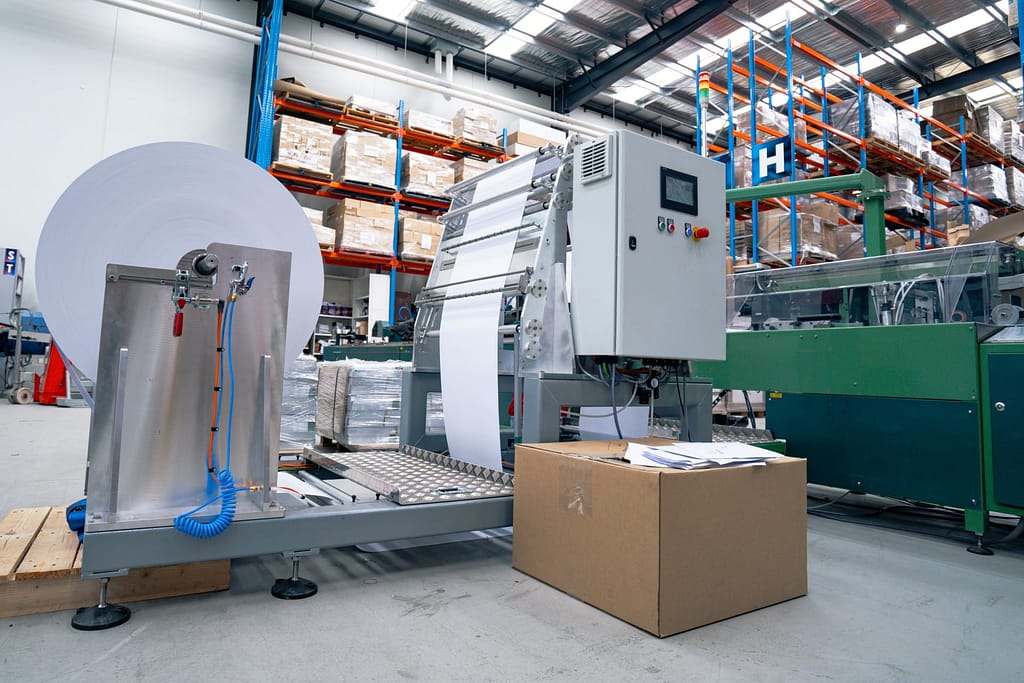[[{“value”:”
Prime Creative Media is Australia’s first publisher to send paper wrapped magazines at scale, in partnership with its printing and mailing supplier FSG.
Based in Bayswater, Victoria, FSG purchased the country’s first ever paper-wrapping mailing machine in January this year. Imported from UK supplier Norpak, the machine’s ability to wrap publications in paper will eliminate plastic wrapping for several Prime Creative Media titles.
“It’s the evolution of the mailing industry to abolish the use of single-use plastics in mailing magazines,” says Michael Murphy, Owner and Director of FSG Mailing. “This follows the government’s move to get disposable plastics out of our Australian systems.”
Up until this technology was in place, the only alternative option to plastics for publishers was paper envelopes. Murphy notes this was cost prohibitive for many clients, because the price of producing and printing the envelopes was high, in addition to the labour of either hand inserting magazines into the envelopes, or using very expensive equipment to insert into the envelopes and seal them. This added a significant increase to mailing costs.
Mailing houses like FSG have experimented over the years with bioplastics, and recyclable plastics, but Murphy says the technology never quite worked out.
“We tried to use bioplastics but the settings on the machines – which use heat to seal them – make it very difficult,” he says. “Even for those companies who worked out how to mail them, it was a challenge for consumers to separate the plastics at the end of the process, or find appropriate disposal. Eventually, we saw that the only real option was paper.”
Murphy came across this technology through his supplier, Norpak, which previously supplied his plastic wrapping machine.
“They introduced us to the idea because they saw what was happening in the European Union with the phase out of single-used plastics,” says Murphy. “With the Australian government making similar moves towards a full phase out of single-use plastics, we think that this machine will be the catalyst to push the movement along in the mailing industry.”
Murphy notes that in Europe, where it was put into commercial use 18 months ago, it has already taken off.
“The first person to use the machine really took a leap in the dark. Now he has 13 of these machines, and those plastic wrapping machines are sitting there not being used – they are becoming museum pieces,” says Murphy. “That will be the future in Australia now that this machine has arrived.”
An additional environmental benefit to the machine is that because the addresses are printed directly onto the paper wrapping, it eliminates the need for flysheets – the paper that lists the addresses and is placed onto a magazine. This improves efficiency, as it limits the printing and transportation of flysheets. It also means that only a small amount of more paper is being used in with the new system, once you take into account the paper used in flysheet printing. And of course, this opens up a vast array of options in using recycled and sustainable paper products
The only drawback, Murphy notes, is that the paper is less weather-proof. In Europe many people live in apartments instead of houses, and magazines are delivered in post boxes or through slits in doors. He says it’ll be interesting to see how the paper stands up to Australia’s climate, but confident it will work well. That being said, he notes the price of an occasional damp magazine is one worth paying to save thousands of tonnes of plastic wrapping from going to landfill every year.
Prime Creative Media COO Christine Clancy was on site at FSG in Bayswater to witness the first publications being sent out in paper-wrapping.
“It’s such an honour to watch history in the making, to see our publications make this first step in reducing single use plastics in our environment,” says Clancy.
She notes that the company has long been involved in supporting the growth of the waste management industry, through its publications Inside Waste and Waste Management Review, along with its annual Waste Awards.
“After years of reporting on the challenges of single-use plastics in the waste industry, it’s so wonderful for us to play a proactive part in it by reducing our own use,” says Clancy. “We’re fortunate to have FSG as a partner to help make this happen.”
For more information, visit www.primecreative.com.au and www.fsg.com.au
The post GCR publisher first to use paper-wrapping mailing machine appeared first on Global Coffee Report.
“}]]


